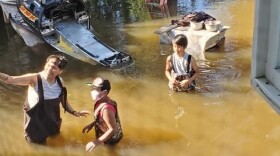
Last month was the rainiest August in Kotzebue’s history — two-and-a-half times the normal amount, and just fractions of an inch from being the wettest month on record.
“This much rain is really remarkable,” said Rick Thoman, a climate specialist at the University of Alaska Fairbanks.
Thoman said it was an “excessively wet” month across most of northern and western Alaska, from the North Slope to the Western Interior. One weather station on the upper Noatak River got three more inches of rain than the previous record.
Thoman said more rain and coastal flooding will be possible for several more weeks, until the sea ice forms.
The region has seen big fall storms before, like Typhoon Merbok back in 2022. Last year, two families in Kotzebue lost their homes in a late October flood.



While the majority of the damage from those storms was in coastal areas, Thoman said the recent rains are affecting inland river communities, too. About 50 miles north of Kotzebue, high water from Noatak River is eroding Noatak’s shoreline.
Jeff Luther, the environmental coordinator for the Native village of Noatak, uses a drone to watch the land and river for drastic changes.
“It's a concern for locals,” Luther said. “They haven't seen this type of erosion before.”
Last fall, the state declared an emergency for Noatak after erosion unearthed pipes connecting the community’s drinking water.
Luther said his biggest concern right now is high water that threatens the community's power plant. He says four fuel tanks need to be moved before they fall into the Noatak River. But there are other issues, too.
Luther said the community’s store is close to the encroaching shoreline, and erosion is threatening Noatak’s runway.
Luther says the boat launch has washed out, and so has the gravel pit.
“We can't even construct a new gravel access road right now,” Luther said. “The gravel pit is underwater.”
Over a hundred miles southwest of Noatak, the small village of Kobuk faces its own issues from heavy rains. At least one resident said by phone last week that it had rained for eight days straight, which prompted a flood advisory from the National Weather Service.
“A lot of rain, and it's still raining out there. It affected a lot of people around here in Kobuk, because people couldn't make it to stores,” said Kobuk Vice Mayor Teresa Barr. “Everybody was moving stuff up and putting stuff by the airport, and it's still raining out there.”
Barr said the flooding closed the school for a week and a half and cut off access to about half of the town. Many residents had to commute to work using boats, and people without boats couldn’t leave their homes.
Barr says although the community has flooded the last few years, she’s noticed more water at higher elevations this year. She said some of the water has receded, but the Kobuk River remains high, and some residents are still commuting by boat.
Meanwhile, Barr said she’s nervous about more rain in the forecast.






